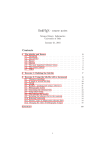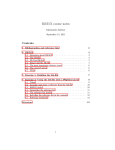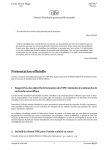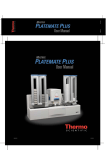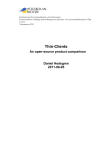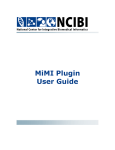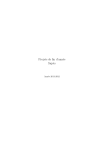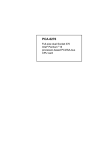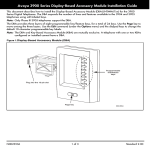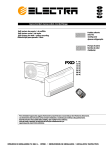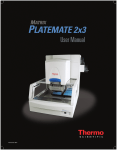Download BibTeX course notes
Transcript
BibTeX course notes
Science library. Informatics
University of Oslo
September 13, 2012
Contents
1 Bibliographies and reference lists
2 BibTeX
2.1 Literature about BibTeX . . .
2.2 GUI for BibTeX . . . . . . .
2.3 The bib-file . . . . . . . . . .
2.4 Emacs and the bib-file . . . .
2.5 Fields . . . . . . . . . . . . .
2.6 Uppercase letters and initials
2.7 Identifiers . . . . . . . . . . .
2.8 Some useful Emacs functions
2.9 Macros . . . . . . . . . . . . .
2.10 The most important reference
2.11 The crossref option . . . . . .
2.12 URLs . . . . . . . . . . . . .
. . . .
. . . .
. . . .
. . . .
. . . .
. . . .
. . . .
. . . .
. . . .
types
. . . .
. . . .
2
.
.
.
.
.
.
.
.
.
.
.
.
.
.
.
.
.
.
.
.
.
.
.
.
.
.
.
.
.
.
.
.
.
.
.
.
.
.
.
.
.
.
.
.
.
.
.
.
.
.
.
.
.
.
.
.
.
.
.
.
.
.
.
.
.
.
.
.
.
.
.
.
.
.
.
.
.
.
.
.
.
.
.
.
.
.
.
.
.
.
.
.
.
.
.
.
.
.
.
.
.
.
.
.
.
.
.
.
.
.
.
.
.
.
.
.
.
.
.
.
.
.
.
.
.
.
.
.
.
.
.
.
.
.
.
.
.
.
.
.
.
.
.
.
.
.
.
.
.
.
.
.
.
.
.
.
.
.
.
.
.
.
.
.
.
.
.
.
.
.
.
.
.
.
.
.
.
.
.
.
.
.
.
.
.
.
.
.
.
.
.
.
3 Exercise 1: Building the bib-file
4 Exercise 2: Using the bib-file with a document
4.1 Citing . . . . . . . . . . . . . . . . . . . . . . . .
4.2 Locating and using a reference from the bib-file .
4.3 BibTeX styles . . . . . . . . . . . . . . . . . . . .
4.4 Generating the reference list . . . . . . . . . . . .
4.5 The reference list header . . . . . . . . . . . . . .
4.6 Including the reference list in the contents . . . .
4.7 Referring backwards . . . . . . . . . . . . . . . .
Literature
3
3
3
3
3
4
4
4
4
5
5
6
6
7
.
.
.
.
.
.
.
.
.
.
.
.
.
.
.
.
.
.
.
.
.
.
.
.
.
.
.
.
.
.
.
.
.
.
.
.
.
.
.
.
.
.
.
.
.
.
.
.
.
.
.
.
.
.
.
.
.
.
.
.
.
.
.
9
9
9
10
10
11
11
11
12
1
Preface
This paper deals with the practical exercises in the BibTeX-course. The exercises will help you build the bibliography given in the article entitled User
interface from Encyclopedia of computer science[1].
1
Bibliographies and reference lists
What is a bibliography?
A bibliography is a list of literature sharing some common aspect. This might
be a person, a subject, an area (national bibliographies) and others.
• Within computer science there are a lot of bibliographies covering the
different parts of the field. Many of these bibliographies are available in
the service The Collection of Computer Science Bibliographies[2].
This service contains bibliographies in many categories: Artificial Intelligence, Compiler Technology, Programming Languages and Type Theory,
Database Research, Distributed Systems, Networking and Telecommunications, Computer Graphics and Vision, Logic Programming, (Computational) Mathematics, Neural Networks, . . .
All together more than 3 000 000 records (duplicates included).
• Digital Bibliography & Library Project (DBLP -see our home page) contains mainly journal articles, conference papers and links to the home
pages of computer scientists.
• National bibliographies are another type of bibliography. They cover all
that is published within a country.
• Person bibliographies usually cover all that is written by and about a
certain person.
What is a reference list? Why refer?
Without a reference list, a thesis is not finished. When working with research
you always base your work more or less on previous works done by others. If
you don’t cite them when you do, it will be considered theft or plagiarism.
The reference list in your thesis should contain information on every document that you either cite, are referring to or from which you use ideas, definitions, illustrations, graphs, statistics or other results.
The body text must contain citations which are pointers to the reference
list. The reference list contains all the information that is necessary to locate
and access the source.
Now, how far should you go in citing? This varies from discipline to discipline.
When giving definitions of concepts you should always cite the source, because this tells the reader what context your operate within.
What might be considered as common knowledge, like the fact that the earth
moves around the sun[3], need not be cited. What is common knowledge in one
discipline, might not be in another. It also depends on for whom you are writing.
2
You should cite the primary source. A secondary source might not have
understood or cited the primary source correctly.
The importance of consistent and correct references
The purpose of the reference list is to show what previous research your own
work is based on and to give the readers of your work a chance to evaluate it.
This means that references must contain the necessary and sufficient information elements to identify and locate the described document.
This course deals with the question of making a proper reference list using
the tool BibTeX.
2
BibTeX
2.1
Literature about BibTeX
Dag Langmyhr has written a short guide to BibTeX (in Norwegian)[4]. You
will find English texts on BibTeX in [5, 6, 7] which may be borrowed from the
library.
A wiki-book on LATEX includes a useful page on BibTeX [8].
2.2
GUI for BibTeX
You will find several tools for handling BibTeX-references on the net. Among
these are:
• JabRef which you can download from http://jabref.sourceforge.net/. It is
written in Java and is said to run on Windows, Mac and Linux.
• Zotero is an elegant add-on for the Firefox web browser. It may be downloaded from http://www.zotero.org. The add-on may be used for collecting
and editing references downloaded from web pages. Zotero may export
references in BibTeX-syntax to a bib-file which may be used with LATEX.
Zotero was also mentioned in the master introduction lecture, you will
find the slides via
http://tinyurl.com/ifibib
2.3
The bib-file
References are collected in a file with the extension bib. The connection between
the LATEX file and the references in the bib-file is established by using identifiers
(see below).
The bib-file may reside in the same file catalogue as the LATEX file or you
may put it in file catalogue ~/texmf/bibtex/bib where BibTeX always will find
it.
2.4
Emacs and the bib-file
Emacs uses a certain BibTeX-mode when you open a bib-file.
Create a folder called bibtexcourse in your home directory.
3
Open a file named references.bib in Emacs by giving the command:
> emacs references.bib &
You will see a menu called Entry-Types. When you want to enter a new
reference in your bib-file, you choose reference type from this menu. Observe
that there are keyboard short cuts for this operation.
After chosing a reference type you will see a list of empty fields, like this
(article in journal or Ctrl-c Ctrl-e Ctrl-a):
@Article{,
author =
title =
journal =
year =
OPTkey =
OPTvolume =
OPTnumber =
OPTpages =
OPTmonth =
OPTnote =
OPTannote =
}
2.5
{},
{},
{},
{},
{},
{},
{},
{},
{},
{},
{}
Fields
The fields prefixed OPT are optional, the others are mandatory. Sometimes two
or more fields are prefixed with ALT. You must enter data into one of them.
The fields are separated by comma.
The text in the fields must be surrounded by quotes (“ ”) or curly braces
({}). There are two exceptions: you may enter clean numbers (a four digit year)
and macros without quotes (or braces).
2.6
Uppercase letters and initials
Information in some of the fields will be edited according to the BibTeX-style
you have chosen. Uppercase letters might be converted to lowercase. If you
want to keep your own layout (e.g. acronyms like ACM and IEEE or person
names in titles) put curly braces around your text.
Initals in personal names should be entered with period and a blank, like
this Knuth, D. E..
2.7
Identifiers
Every reference in the bib-file must include a unique identifier. It must be
entered right after the first curly brace. A comma concludes the identifier.
As you are going to use this identifier when citing in your main LATEXdocument you should construct it easy to memorize, like: shneiderman1983 and
olsen1992.
2.8
Some useful Emacs functions
• Emacs: TAB sets the cursor at the end of the current field
• Emacs: Ctrl-J at the beginning of the next field
4
• Emacs: If you select the menu BibTeX-Edit > Operating on
Buffer or Region > Validate Entries a syntax check is performed
on the bib-file.
• Emacs: Ctrl-c Ctrl-c concludes the entering of a reference. You
will be warned about empty mandatory fields. Emacs will propose
an identifier if you have not entered one yourself. Empty optional
fields will be removed.
• Linux: you may print the whole bib-file by using the command
printbib myfile.bib. This generates a dvi file that may be printed.
The references will be sorted by identifier. If you want the list in a
special style you use the command printbib -s style myfile.bib.
2.9
Macros
Some information occurs often. It may be journal titles, publisher names, personal names and so on. To save typing and to ensure consistency you may use
macros. The definition of the macro must appear in the beginning of the bib-file.
Examples:
@string{shn = "Ben Shneiderman"}
@string{ojd = "Ole-Johan Dahl"}
@string{atch = "ACM Transactions on Computer-Human Interaction"}
@string{aw = "Addison-Wesley"}
Then you might enter (without curly braces or quotes):
author = ojd
editor = shn
journal = atch
publisher = aw
The macros will be expanded during the bibtex processing.
Some styles have build-in macros for the most common journal titles (see a
list in [4, p.12]).
If you are using several bib biles it will be convienient to gather all your
macros in one single file that should be loaded first (see page 10).
Erase everything in your bib-file and enter the macro for atch.
2.10
The most important reference types
Article
Mandatory:
Recommended:
author, title, journal, year
volume, number, pages.
Book
Mandatory:
title, publisher, year and at least one of
author or editor.
5
InBook/InCollection
The type inBook is meant for paragraphs, chapters and page interval in a book.
The type inCollection is meant for independent contributions in a book or collection (anthology).
Mandatory for InBook:
author/editor, title, chapter, publisher, year.
Mandatory for InCollection: author, title, booktitle.
Recommended:
publisher, year.
InProceedings – conference paper
Mandatory:
Recommended:
author, title, booktitle.
year, publisher, pages.
Mastersthesis/PhdThesis
Mandatory for both:
author, title, school, year.
TechReport
Mandatory:
Recommended:
2.11
author, title, institution, year
number (report number)
The crossref option
If you have several references from the same collection or conference it would be
rather cumbersome to enter the shared information concerning the collection or
the conference.
The solution is to enter a reference (book, collection or proceedings) that
covers the whole document with the shared information, like book title.
The references concerning the parts (chapter, paper) might then include the
field crossref containing the identifier of the shared document.
BibTeX will then merge the information from the part (e.g. inBook/Book,
inProceedings/Proceedings) and the whole.
When using the crossref option make sure that the part references appears
before the whole references in the bib file. inBook before Book.
2.12
URLs
All reference types in BibTeX may include the field url, but only the harvard
styles will show the data from this field.
The solution is to put the URL in the note field together with the date that
the URL was last accessed.
Date is important by several reasons. First of all: web pages have a tendency
to change over time, you should document which version (date) you are referring
to. Second: the documents often change their URLs.
It is also recommended that you keep a printed copy of the page for later
control. Examples: [2, 3]
To ensure a proper typographical handling of the URL you should use the
command \url which is included in the url-package. Include the following in
the LATEX-header:
6
\usepackage[T1]{url}
\urlstyle{sf}
Then you enter the note field like this:
note = {\newline
\url{http://www.ifi.uio.no/~dag/latex-links/bibtex-guide.pdf}
(2010-09-27)}
and you might see the result in the reference list [4].
3
Exercise 1: Building the bib-file
We will now import references from external sources and enter one by hand.
The references are found on the accompanying sheet which is also the reference
section of this document.
Usually you will download the reference in parallel with downloading the
full document. Make it a habit to fetch the reference data alongside fetching the
document. It will save you a lot of work later on.
1. Hutchins et al., 1986 [9]
Google Scholar
Search for Hutchins 1986 direct in Google Scholar (via Library home
page). Before studying the hit list, do this: select Scholar preferences
from the cogwheel up right. Scroll down to the section on Bibliography
manager. Tick off Show links to import citations into and select BibTeX
in the pull down menu. Save the preferences.
Take a look at the first hit in the list. Click the link Import into BibTeX.
You will then see the reference with BibTeX-syntax. Is this the reference
we were looking for?1
Study other reference candidates down the page. Do you notice any peculiarities?2
Collection of Computer Science Bibliographies (CCSB)
We will now try to find the reference in the CCSB. Click Search in the
horisontal menu in the start page. Enter Hutchins in the search field and
select author as qualifier and 1986 as publication year.
The second hit is the one we’re after. To the right you will see two links:
BibTeX and 4 duplicates. Study the four duplicates and go back to take
a look at the BibTeX-link. Copy the reference into your bib-file.
2. Olsen, 1992 [10]
Google Scholar
Go back to Google Scholar and try to find this reference by searching for
olsen user interface management. Click Import into BibTeX link. Is it
OK?3 . Copy the reference to the bib-file.
1 No
2A
lot of citations of the relevant document are listed
3 Yes
7
3. Your own thesis
Entering data from scratch
Select the correct reference type from the menu and enter data in the
mandatyory fields. Enter the command Ctrl-c Ctrl-c to clean up the
record and generate an identifier.
4. Johnsen et al., 1989 [11]
IEEE Xplore
This reference you will find in the IEEE Xplore service. Search for johnson
xerox star and tick the reference and click Download citations. Choose
Citation only and BibTeX. Finally click Download citations. Copy the
reference to the bib-file.
5. Shneiderman 1983 [12]
IEEE Xplore
Search for Shneiderman 1983 and follow the procedure above.
6. Jacob, 1986 [13]
This reference we will find in ACM Digital Library.
A general description of the procedure: Click the title of the article in a
hit list. The page which appear has a grey text box to the right, marked
Tools and Resources. At the bottom of this box there is a BibTeX-link.
Move to the ACM Digital Library from the library home page. Click
Journals and Transactions under the Browse the digital library header.
You will get a list of all the journals of ACM (some called transactions).
Locate the journal ACM Transactions on Graphics 4 . Navigate to the
journal page, then to the publication archive, to the correct issue and
finally to the table of contents.
Study the BibTeX reference. Note that ACM abbreviates the journal
name. Copy the reference to your bib-file and correct the journal name.
7. Hartson, 1989 [14]
ACM Digital Library
Locate the journal Computing Surveys. See above.
8. Myers, 1995 [15]
ACM Digital Library
Locate the journal ACM Transactions on Computer-Human Interaction.
See above.
9. Foley, 1987 [16]
Collection of Computer Science Bibliographies (CCSB)
Click Search in the horisontal menu on the start page. Enter Foley in the
search field and select author as qualifier and 1987 as publication year.
10. Foley, 1990 [17]
See above.
4 Use
Ctrl-f to search within the list
8
11. Shneiderman, 1992 [18]
See above.
12. Stephenson, 1999 [19]
See above.
4
Exercise 2: Using the bib-file with a document
In this exercise you will use text located in the URL
http://folk.uio.no/knuthe/bibtex/exampletext.html
Copy the text into Emacs in a file called userinterface.tex. Your job is to replace
every doble-* reference with a proper LATEX citation command.
4.1
Citing
You must use a cite command when you want to include a citation in your
text. The command takes the reference identifier as mandatory parameter, like
this:
\cite{identifier}
The identifier must be written exactly as it appears in the bib-file.
If you want to cite several references in the same cite command, it would
look like this:
\cite{identifier1, identifier2}
If you want to refer to a certain page within the document the cite takes another
parameter:
\cite[page 47]{identifier}
If you want a reference to appear in your reference list without explicitly citing
it, you may write:
\nocite{identifier}
If you replace identifier with *, all of the references in your bib-file will a
appear in your reference list.
4.2
Locating and using a reference from the bib-file
An Emacs add-on (RefTeX) makes it easy to handle citations[20]. The package
is recommended also by other reasons. It handles internal crossreferences in the
tex file and makes it easy to use table of contents in Emacs.
You put Emacs in RefTEX mode by giving the command M-x reftex-mode.
Please note the new top menu (Ref). You may set Emacs in RefTeX mode
initially by adding these commands to the .emacs file:
(autoload ’reftex-mode "reftex" "RefTeX Minor Mode" t)
(autoload ’turn-on-reftex "reftex" "RefTeX Minor Mode" nil)
(add-hook ’LaTeX-mode-hook ’turn-on-reftex)
9
This mode will make it possible to locate references by regular expressions:
Place the cursor where the cite-command should be. Select \cite from the
Ref menu (or use the command Ctrl-c [). Enter the regular expression plus
Return. Eventually you will get a hist list. You may navigate in the hit list by
using the up/down arrows and selecting a reference by return. A cite command
will appear with the correct identifier. The point of using easy-to-remember
identifiers is not that important any longer.
If you require two or more citations in your cite-command, just place the
cursor before the last curly brace and repeat the RefTeX cite-command.
Now, replace the doble-* citations with proper cite-commands in the rest of
the text.
4.3
BibTeX styles
Several bibliographic styles are defined in BibTeX. Her are some commonly used
styles:
• plain – the reference list is sorted alphabetically by first author and given
a running number. The citation is a number in brackets.
• unsrt – looks like plain, but the list is sorted in the same sequence as the
citations appear in the document. The current document uses unsrt.
• abbrv – as plain, but with compacted references.
These styles are variations of numbered styles which is frequently used in computer science literature.
If you have a lot of references in your document, it is more user friendly
when the citation includes author name and year (Shneiderman, 1983). Such
styles are included in the packages chicago and harvard. If you want to use such
styles, you must include the package in the header of the LATEX-file:
\usepackage{chicago}
\usepackage{harvard}
4.4
Generating the reference list
Put these commands in the LATEX-file where you want the reference list to
appear:
\bibliography{references}
\bibliographystyle{plain}
(the bib-file)
(the style)
If you use several bib-files, separate them by comma and if you use a separate
file for macros (macros.bib) it might look like this
\bibliography{macros,references}
\bibliographystyle{plain}
Running LATEX on the tex-file all \cite, \bibliography and \bibliographystyle
commands are noted in the aux-file and you get the message:
LaTeX: there were unresolved citations
10
Then you run the command > bibtex tex-filename (without extension) and
hopefully get the message
BibTeX finished successfully. Run LaTeX again to get citations right.
Running LATEX will give the message:
You should run LaTeX again to get references right
and finally, after running LATEX once more:
LaTeX: successfully formatted {n} pages.
If you want to see the result, click on the DVI-symbol.
Try the agsm-style from the harvard-package and repeat the procedure.
4.5
The reference list header
The header of the reference list is taken from the value of a LATEX-variable.
The name of the variable is refname when using the document class article, and
bibname for the book document class. The default values of these variables are
References and Bibliography respectively.
You may give these variables new values by using the renewcommand like
this:
\renewcommand{\refname}{Literature}
4.6
Including the reference list in the contents
The reference list is not included in the contents automatically. To add an entry
in the content you give this command:
\addcontentsline{toc}{section}{\refname}
where the reference is to appear.
The redefinition of the refname variable and the addcontentsline-command
should appear together to ensure consistency:
\renewcommand{\refname}{Literature}
\addcontentsline{toc}{section}{\refname}
4.7
Referring backwards
When your document grows, it will be difficult to remember just where you
cited a certain reference.
You may use the package hyperref which generates backward citations. That
is, for every reference in the reference list page numbers are added to show where
the reference is cited. To achieve this, you add the following command in the
LATEX-header:
\usepackage[pagebackref=true]{hyperref}
If pagebackref is set to false the page numbers disappear from the reference
list. The hyperref package also generates internal and external links in the
document.
August 2012
/undervisning/bibtex-kurs/bibtexfolder.tex
11
(notes)
12
Literature
[1] Robert J. K. Jacob. User interface. In Anthony Ralston, Edwin D. Reilly,
and David Hemmendinger, editors, Encyclopedia of computer science, pages
1821 – 1826. Nature publishing Group, 4 edition, 2000. 2
[2] Alf-Christian Achilles and Paul Ortyl. The Collection of Computer Science
Bibliographies.
http://liinwww.ira.uka.de/bibliography/index.html (2012-08-20). 2, 6
[3] Nicolaus Copernicus. De Revolutionibus Orbium Coelestium. apud. Ioh.
Petreium, 1543. Se også:
http://ads.harvard.edu/books/1543droc.book (2012-08-20). 2, 6
[4] Dag Langmyhr. Lokal guide til BibTeX, Desember 2008.
http://www.ifi.uio.no/~dag/latex-links/bibtex-guide.pdf (2012-08-20). 3, 5,
7
[5] Helmut Kopka and Patrick W. Daly. A guide to LATEX2ǫ : document preparation for beginners and advanced users. Addison-Wesley, 2 edition, 1995.
3
[6] Helmut Kopka and Patrick W. Daly. Guide to LATEX: tools and techniques
for computer typesetting. Addison-Wesley, 4 edition, 2004. 3
[7] Apostolos Syropoulos, Antonis Tsolomitis, and Nick Sofroniou. Digital
typography using LATEX. Springer, 2002. 3
[8] Latex/bibliography management. Webpage, 2012.
http://en.wikibooks.org/wiki/LaTeX/Bibliography_Management
20). 3
(2012-08-
[9] E. L. Hutchins, J. D. Hollan, and Donald A. Norman. Direct manipulation
interfaces. In Donald A. Norman and Stephen W. Draper, editors, User
centered system design: new perspectives on human-computer interaction,
pages 87–124. Lawrence Erlbaum, Hillsdale, 1986. 7
[10] D.R. Olsen. User interface management systems: models and algorithms.
Morgan Kaufmann, San Francisco, 1992. 7
[11] J. Johnson, T. L. Roberts, W. Verplank, D. C. Smith, C. H. Irby, M. Beard,
and K. Mackey. The Xerox Star: a retrospective. Computer, 22(9):28–29,
1989. 8
[12] B. Shneiderman. Direct manipulation: A step beyond programming languages. Computer, 16(8):57–69, 1983. 0018-9162. 8
[13] Robert J. K. Jacob. A specification language for direct-manipulation user
interfaces. ACM Trans. Graph., 5(4):283–317, 1986. 8
[14] H. Rex Hartson and Deborah Hix. Human-computer interface development:
concepts and systems for its management. ACM Comput. Surv., 21(1):5–92,
1989. 8
13
[15] Brad A. Myers. User interface software tools. ACM Trans. Comput.-Hum.
Interact., 2(1):64–103, 1995. 200971. 8
[16] J.D. Foley. Interfaces for advanced computing.
257(4):127–135, 1987. 8
Scientific American,
[17] James D. Foley. Computer graphics: principles and practice. AddisonWesley, Reading, Mass., 1990. 8
[18] Ben Shneiderman. Designing the user interface: strategies for effective
human-computer interaction. Addison-Wesley, Reading, Mass., 1992. 9
[19] Neal Stephenson. In the beginning ...was the command line. Avon Books,
New York, 1999. 9
[20] Carsten Dominik. RefTeX user manual, 4.34 edition, August 2009.
http://www.gnu.org/software/auctex/manual/reftex.pdf (2012-08-20). 9
14














